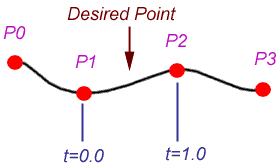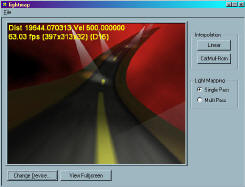hey there,
Since i really really need the CatmullRomCurve and it had a bug, I decided to fix it.
The bug is (don't know if anyone else noticed) that the curve had weird 'loops' at both ends. Thats because it doesnt know how to describe the curve if there are not 2 checkpoints to both sides of the wanted point. the original author just set the second point the same as the fist (nearest to the wanted point), that is/was the bug, because it had to be further away (minimally) to eliminate the loops.
Heres the fixed Code:
public class CatmullRomCurve extends Curve {
private static final long serialVersionUID = 1L;
private Vector3f tempVec0 = new Vector3f();
private Vector3f tempVec1 = new Vector3f();
private Vector3f tempVec2 = new Vector3f();
private Vector3f tempVec3 = new Vector3f();
private Vector3f tempVec4 = new Vector3f();
private Vector3f firstPoint = new Vector3f();
private Vector3f lastPoint = new Vector3f();
private float partPercentage;
private Vector3f first;
private Vector3f second;
private Vector3f last;
private Vector3f beforeLast;
/**
* Constructor instantiates a new <code>CatmullRomCurve</code> object.
*
* @param name the name of the scene element. This is required for identification and comparision purposes.
*/
public CatmullRomCurve(String name) {
super(name);
}
/**
* Constructor instantiates a new <code>CatmullRomCurve</code> object. The control points that define the curve are
* supplied.
*
* @param name the name of the scene element. This is required for identification and comparision purposes.
* @param controlPoints the points that define the curve.
*/
public CatmullRomCurve(String name, Vector3f[] controlPoints) {
super(name, controlPoints);
this.partPercentage = 1.0f / (getBatch(0).getVertexCount() - 1);
first = new Vector3f();
second = new Vector3f();
last = new Vector3f();
beforeLast = new Vector3f();
BufferUtils.populateFromBuffer(first, getBatch(0).getVertexBuffer(), 0);
BufferUtils.populateFromBuffer(second, getBatch(0).getVertexBuffer(), 1);
BufferUtils.populateFromBuffer(beforeLast, getBatch(0).getVertexBuffer(), getBatch(0).getVertexCount() - 2);
BufferUtils.populateFromBuffer(last, getBatch(0).getVertexBuffer(), getBatch(0).getVertexCount() - 1);
Vector3f firstTangent = second.subtract(first);
firstTangent.normalizeLocal();
firstTangent.multLocal(0.01f);
first.mult(firstTangent, this.firstPoint);
Vector3f lastTangent = beforeLast.subtract(last);
lastTangent.normalizeLocal();
lastTangent.multLocal(0.01f);
last.mult(lastTangent, this.lastPoint);
}
/**
* <code>getOrientation</code> calculates the rotation matrix for any given point along to the line to still be
* facing in the direction of the line.
*
* @param time the current time (between 0 and 1)
* @param precision how accurate to (i.e. the next time) to check against.
* @return the rotation matrix.
* @see com.jme.curve.Curve#getOrientation(float, float)
*/
public Matrix3f getOrientation(float time, float precision) {
Matrix3f rotation = new Matrix3f();
// calculate tangent
Vector3f point = getPoint(time);
Vector3f tangent = point.subtract(getPoint(time + precision));
tangent = tangent.normalize();
// calculate normal
Vector3f tangent2 = getPoint(time - precision).subtract(point);
Vector3f normal = tangent.cross(tangent2);
normal = normal.normalize();
// calculate binormal
Vector3f binormal = tangent.cross(normal);
binormal = binormal.normalize();
// set columns
rotation.setColumn(0, tangent);
rotation.setColumn(1, normal);
rotation.setColumn(2, binormal);
return rotation;
}
/**
* <code>getOrientation</code> calculates the rotation matrix for any given point along to the line to still be
* facing in the direction of the line. A up vector is supplied, this keep the rotation matrix following the line, but
* insures the object's up vector is not drastically changed.
*
* @param time the current time (between 0 and 1)
* @param precision how accurate to (i.e. the next time) to check against.
* @return the rotation matrix.
* @see com.jme.curve.Curve#getOrientation(float, float)
*/
public Matrix3f getOrientation(float time, float precision, Vector3f up) {
if (up == null) {
return getOrientation(time, precision);
}
Matrix3f rotation = new Matrix3f();
// calculate tangent
Vector3f tangent = getPoint(time).subtract(getPoint(time + precision));
tangent = tangent.normalize();
// calculate binormal
Vector3f binormal = tangent.cross(up);
binormal = binormal.normalize();
// calculate normal
Vector3f normal = binormal.cross(tangent);
normal = normal.normalize();
// set columns
rotation.setColumn(0, tangent);
rotation.setColumn(1, normal);
rotation.setColumn(2, binormal);
return rotation;
}
/*
* (non-Javadoc)
*
* @see com.jme.curve.Curve#getPoint(float)
*/
@Override
public Vector3f getPoint(float time) {
return getPoint(time, new Vector3f());
}
/**
* <code>getPoint</code> calculates a point on a Catmull-Rom curve from a given time value within the interval [0,
* 1]. If the value is zero or less, the first control point is returned. If the value is one or more, the last
* control point is returned. Using the equation of a Catmull-Rom Curve, the point at the interval is calculated and
* returned.
*
* @see com.jme.curve.Curve#getPoint(float)
*/
@Override
public Vector3f getPoint(float time, Vector3f point) {
// first point
if (time <= 0) {
BufferUtils.populateFromBuffer(point, getBatch(0).getVertexBuffer(), 0);
return point;
}
// last point.
if (time >= 1) {
BufferUtils.populateFromBuffer(point, getBatch(0).getVertexBuffer(), getBatch(0).getVertexCount() - 1);
return point;
}
float timeBetween = time / this.partPercentage;
int firstPointIndex = ((int)FastMath.floor(timeBetween));
time = timeBetween - firstPointIndex;
float t = time * 0.5f;
float t2 = t * time;
float t3 = t2 * time;
firstPointIndex--;
if (firstPointIndex == -1) {
tempVec1 = first.subtract(second.subtract(first).normalize().mult(0.0001f));
} else {
BufferUtils.populateFromBuffer(tempVec1, getBatch(0).getVertexBuffer(), firstPointIndex);
} // else
BufferUtils.populateFromBuffer(tempVec2, getBatch(0).getVertexBuffer(), ++firstPointIndex);
BufferUtils.populateFromBuffer(tempVec3, getBatch(0).getVertexBuffer(), ++firstPointIndex);
if (++firstPointIndex == getBatch(0).getVertexCount()) {
tempVec4 = last.subtract(beforeLast.subtract(last).normalize().mult(0.0001f));
} else {
BufferUtils.populateFromBuffer(tempVec4, getBatch(0).getVertexBuffer(), firstPointIndex);
} // else
point.zero();
tempVec1.mult(-t3 + 2 * t2 - t, point).addLocal(tempVec2.mult(3 * t3 - 5 * t2 + 1, tempVec0)).addLocal(
tempVec3.mult(-3 * t3 + 4 * t2 + t, tempVec0)).addLocal(tempVec4.mult(t3 - t2, tempVec0));
return point;
}
/*
* (non-Javadoc)
*
* @see com.jme.scene.Spatial#findCollisions(com.jme.scene.Spatial, com.jme.intersection.CollisionResults)
*/
@Override
public void findCollisions(Spatial scene, CollisionResults results) {
} // findCollisions
/*
* (non-Javadoc)
*
* @see com.jme.scene.Spatial#hasCollision(com.jme.scene.Spatial, boolean)
*/
@Override
public boolean hasCollision(Spatial scene, boolean checkTriangles) {
return false;
}
/*
* (non-Javadoc)
*
* @see com.jme.scene.Spatial#doPick(com.jme.math.Ray, com.jme.intersection.PickResults)
*/
@Override
public void findPick(Ray toTest, PickResults results) {
} // findPick
} // CatmullRomCurve
so long,


